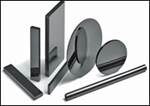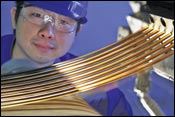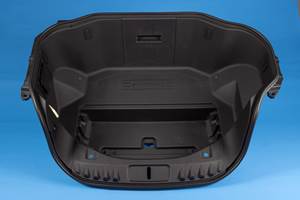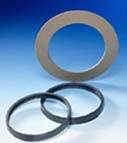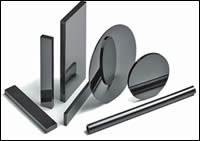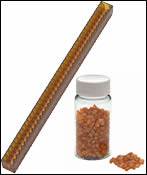Extreme Plastics New Contenders Push Limits Of Heat and Chemical Resistance
The top of the thermoplastic performance pyramid is growing more crowded and more finely differentiated due to heightened demand for lighter, tougher alternatives to metals, ceramics, and thermosets.
Not so long ago, if you needed the ultimate that a thermoplastic could offer in heat or chemical resistance, stiffness, and strength, there was a limited number of choices. They were primarily polyether ether ketone (PEEK), thermoplastic polyimide (TPI), polybenzimidazole (PBI), high-temperature sulfones, and polyamide-imide (PAI). Each was represented by one resin family from one supplier, and they quietly carved out respectable low-volume market niches in specialty automotive, semiconductor, aerospace, electrical/electronics, and other industrial applications.
Today it’s a more crowded field with additional resin choices and more suppliers, at least one of which coined the phrase “ultra polymers” to identify the peak of the high-performance polymers segment. The “ultra” category is distinguished from what have long been known as “high-performance” thermoplastics—high-temperature nylons, fluoropolymers, polysulfone, polyethersulfone, liquid-crystal polymers (LCPs), polyetherimide (PEI), and PPS. While all of the latter are a cut above standard engineering thermoplastics in price and performance, they have limitations in heat or chemical resistance and disadvantages in processing and brittleness.
The “ultras” have broken out of the “high-performance” category and landed at the top tier of the performance pyramid because of a combination of superior thermal properties (HDT of at least 240 C) and other multiple superlatives in strength, toughness, and chemical resistance. “It’s a case where they don’t necessarily all have the highest heat resistance, but these materials are the best at more than one thing,” says Chris Wilson, business director for Solvay’s “ultra polymer” line.
The comfort factor
“Ultra” polymers are still a small market with total demand estimated at between 6.6 million and 8.8 million lb/yr for injection molded and extruded applications. But “ultra” polymers are experiencing 15% annual demand growth, according to various industry observers. Maturing product portfolios and commoditization of certain products like polycarbonate and ABS have prompted engineering thermoplastic suppliers to target “ultra” polymers as a potential high-growth opportunity. These suppliers are eager to move away from “commodity” engineering resins and move up the performance chain where there are fewer competitors, more differentiated products, and higher profit margins. Most of these materials range in price from $20/lb to $100/lb. “From the supply side, there are more proprietary products, intellectual protection, and prospects for higher profitability,” says Austin Peppin, senior consultant for market-research firm BRG Peppin.
A key reason for heightened market demand for these materials is their increased acceptance by design engineers and processors. After a long incubation period, early design and processing challenges have been overcome. Designers and processors see these materials as providing greater value in use despite their high cost/lb. In electronics, product life cycles are growing ever shorter, and ever tinier parts are requiring higher heat and chemical resistance. In addition, end users are under intense pressure to reduce energy consumption through use of more lightweight parts, particularly in the automotive and aircraft industries.
For processors, the obvious question is how well these ultra polymers run on existing injection and extrusion equipment. To date, materials like PEEK have met the challenge while others like Solvay’s Torlon PAI, which requires post-curing, have had more limited appeal.
At the higher processing temperatures required, processing machines have more difficulty in efficiently transferring heat from the barrel heaters to the polymer in the screw and in maintaining melt temperatures required to form the part, says Jack Avery of Avery Consultants, Salt Lake City, a former processing expert for GE Plastics. “The issue for processors is the heating capability of their existing equipment; some may have to upgrade the heater bands, while some who already run high-temperature materials may not need to make changes,” explains Avery.
Solvay’s Wilson agrees that processors with no prior experience with high-heat polymers “can’t just go out and crank up the heat.” Modifications in screw configurations and tooling (venting, draft angles, undercuts) must also be addressed.
New players emerge
Victrex USA Inc., the world’s leading supplier of crystalline PEEK resin, has been the dominant player in the “ultra” category, but now is being challenged by new and old competitors, mostly on the amorphous side. “For a long time, Victrex had this market all to itself,” says BRG’s Peppin,.
For one thing, Victrex now has competition in PEEK from Degussa High Performance Polymers and Solvay Advanced Polymers. In fact, the stepped-up market activity in “ultra” thermoplastics is being led by Solvay, which offers the broadest line of “ultra polymers,” some developed internally and some added through acquisitions. Other competitors are Mitsui Chemicals America with a thermoplastic polyimide and, most recently, GE Plastics, which brought out a TP polyimide of its own.
Several “ultra” polymers have been around for a long time, but not until now has there been a focused effort to differentiate them from merely “high-performance” thermoplastics. “It’s a new way of delineating a higher level of performance,” says Howard Blum, v.p. of consulting firm Kline & Co.
The broadest mix
Solvay claims the broadest line of highly heat- and chemical-resistant thermoplastics. A longtime supplier of high-performance resins like Udel polysulfone and Torlon PAI, Solvay has expanded its reach with new product developments and acquisitions. In 2006, the company bought the PEEK polymer line from India’s Gharda Polymers and self-reinforcing polyphenylene (formerly known as Parmax) from start-up company Mississippi Polymer Technologies. These materials, along with internally developed grades of enhanced high-temperature sulfone and PAI, have been branded the SolvaSpire family.
Solvay’s strategy is to fill the price/performance gap between PEEK and high-performance materials like PPS. “Previously, end-users were forced to pay for PEEK because there was no cost-effective material to fit the bill,” said Solvay’s Wilson. New AvaSpire modified PEEK, a lower-cost version with somewhat lower properties, is finding a fit in medical applications as a cost-effective alternative to standard PEEK. The unfilled AvaSpire 650 series is priced 15% to 25% less than standard PEEK. It is used commercially in two medical and surgical devices. While these materials provide high toughness and heat resistance, the lower price brings a compromise in chemical resistance and strength. The 750 series with 40% glass is used as a replacement for reinforced PEEK in industrial and chemical processing applications.
Solvay is also going head to head with Victrex PEEK, offering a drop-in replacement called KetaSpire. It comes in eight grades, including ones with 30% glass and/or carbon fiber. Keta-Spire is made with basically the same process used to make Victrex PEEK (which Solvay also uses to make its sulfone polymers).
The Gatone PEEK products acquired from Gharda are made using a different chemistry, which results in darker color and differences in processability. Solvay offers Gatone primarily in Asia and will discontinue its own Kadel PEEK products.
Both AvaSpire and KetaSpire can be injection molded or extruded on traditional thermoplastic processing equipment. They are made at a semi-commercial plant in Alpharetta, Ga. A new 1.1-million-lb/yr plant is scheduled to come on stream early next year in India. New friction and wear-resistant grades are being developed for both product lines.
On the amorphous resin side, Solvay will introduce a new line of high-heat sulfones called EpiSpire. With an HDT of 230 C to 265 C, these materials will replace roughly equivalent high-heat sulfones produced by different technologies—Solvay’s own Supradel HTS (introduced in late 2004) and Gharda’s Gafone PSS-B. Meanwhile, the Torlon PAI line is being “reinvigorated” with several new upgrades, including new friction and wear products. “Up until now, we’ve under-exploited the potential of PAI,” says Wilson. New enhanced grades reportedly will solve difficulties in molding deep undercuts without internal lubricants.
The former Parmax resin, renamed PrimoSpire, is a novel amorphous resin that has no close cousin. It is described as a “self-reinforcing” polyphenylene (SRP) with a rigid-rod molecular structure that gives it exceptional compressive strength (up to 35,000 psi), one of the highest among thermoplastics. It also offers low moisture absorption, high chemical resistance, inherent flame resistance, and 60% greater strength and stiffness than unreinforced PEEK or PEI. Injection molding, extrusion, and compression molding grades are available.
PrimoSpire chars instead of burning, providing a protective layer in sensitive electronic shielding. Its flame resistance has won it new aerospace ablative applications. SRP costs around $60/lb, about 20% more than standard PEEK.
New challengers in PEEK
Victrex PEEK was patented by ICI in 1978 and later spun off into a separate company. Tim Herr, Victrex’s North American market development leader, distinguishes the company from its new competition because it is dedicated to that one polymer. “We’re a polyketone company, so we compete on a different level.”
Global demand for PEEK has exploded over the last decade. Victrex experienced nearly 19% poundage growth in 2006 in automotive, industrial, food processing, electrical/electronics, and semiconductor markets. In the six months ending March 31, 2007, Victrex’s sales of 2.83 million lb were 15% ahead of the same period a year ago. To meet growing demand, a second plant in the U.K. will boost capacity from 6.16 million to 9.35 million lb/yr when it goes online in October.
In 2001, Victrex founded a separate wholly owned subsidiary, Invibio, to supply biocompatible PEEK-Classix medical grades and implantable PEEK-Optima grades. Its first implantable application was a Japanese arthroscopy device in 2005. Last fall, Invibio introduced Endolign carbon-fiber reinforced PEEK for implantable load-bearing devices.
Among recent Victrex product developments, the company introduced last year Victrex T-Series blends of PEEK and polybenzimidazole (PBI) from PBI Performance Products. Victrex T-Series was introduced for high-temperature applications requiring hardness and wear resistance, as well as improved creep and heat resistance.
The PEEK/PBI alloys come in unreinforced, glass-filled, and wear-resistant versions. A carbon-fiber grade will be introduced soon. T-Series materials boast continuous-use temperatures up to 300 C, compared with 260 C for unmodified PEEK. In semiconductors, a new commercial use is robotic end effectors for silicon wafer pick-up. Other uses include bearings and thrust washers. New PEEK resins and blends are in development.
New PEEK grades with twice the flowability of previous materials are used to replace LCP and PBT in thin-wall connectors exposed to lead-free soldering temperatures. These high-heat connectors are smaller and thinner than previous generations.
At press time in early May, Victrex was planning to introduce its first line of PEEK films and new manufacturing capability later that month (the company declined to disclose details in advance).
Besides Solvay’s two PEEK families, another new entry comes from JIDA Degussa, a joint venture 80% owned by Degussa High Performance Polymers and 20% by Jilin University in Changchun, China. Jilin has worked on PEEK manufacturing and processing technology for more than 15 years, according to Christian Bierhaus, director of strategic projects for Degussa HPP. Degussa expanded its technology base with the 2005 acquisition of know-how and patents from Ticona GmbH in Germany related to polyaryl ether ketones (PAEK). Vestakeep PEEK is produced in China using chemistry similar to that of Victrex and Solvay and is marketed by Degussa. The undisclosed capacity in China is said to be adequate to meet global supply needs and future growth.
Exploding demand for PEEK is fueled in part by increased focus on energy savings via lightweight parts, according to Degussa’s Bierhaus. “Ten years ago there was no need to replace metal in gears. Demand is there now because of the unique high-performance polymers that are available to reduce weight and energy consumption.” Ultra polymers like PEEK are also meeting the demand for faster processing speeds in industries like electronics.
Vestakeep PEEK’s high heat resistance (HDT of 153 to 240 C), chemical resistance, and mechanical properties are comparable to those of competing PEEK resins. The Vestakeep line includes eight grades for injection molding and extrusion. Four unreinforced resins of low to high viscosity (Vestakeep 1000G, 2000G, 3000G, 4000G) are for gears, medical devices, and extruded products. Reinforced grades contain 30% glass or carbon fiber for rigid, low-warpage housings. A specialty molding grade, 4000 FC30, contains 10% graphite, 10% carbon fiber, and 10% PTFE for self-lubricating bearings and gears. A special unreinforced extrusion grade (3001 G) is for wire and cable. Development areas for Vestakeep PEEK include blends and multilayer coextrusions.
A smaller player in polyketones is Oxford Performance Materials, in business since 2003. It supplies polyether ketone ketone (PEKK) materials, which are said to be growing at a 35% annual rate. “It’s taken a while for the market to evolve,” says President Scott DeFelice. “The market is now expanding because performance requirements in many industries have climbed beyond what ordinary engineering thermoplastics could provide.”
Oxford purchases the resin and has “modest” compounding capacity. Its OxPekk line includes 10 grades for injection molding and extrusion. They comprise high- and low-viscosity resins, both unfilled and reinforced with glass or carbon fiber. OxPekk boasts a glass-transition temperature (Tg) of 162 C vs. 142 C for PEEK. Its compressive strength (30,000 psi) is also higher than PEEK’s. Another key feature is the material’s slow crystallization, which reportedly yields reduced stress in molded parts. OxPekk costs 20% more than PEEK.
TPI: Now there are two
Faced with commoditization and shrinking margins within its engineering resin line, GE Plastics has penetrated the ultra category with a new thermoplastic polyimide (TPI). Extem is an amorphous polymer with similar processability but much greater heat resistance than its cousin, Ultem polyetherimide. Tg of Extem is up to 311 C and continuous-use temperature is up to 230 C. It was developed to offer performance properties competitive with other ultra polymers plus improved processability.
Two families and a total of seven resins currently comprise the Extem line, but additional grades are expected this year. Extem UH resins have maximum heat and chemical resistance, including enhanced resistance to chlorinated solvents such as methylene chloride. Higher-flow XH resins have a Tg up to 267 C and can fill thin-wall, complex parts. The materials can be molded and extruded on standard equipment.
GE expects to commercialize applications in semiconductor manufacturing, telecommunications, and electrical/electronics this year. GE is working with its LNP business unit to develop blends with crystalline resins to gain more flow and chemical resistance. Targeted applications include down-hole oil and gas production equipment, bearings, and gears. New wear-resistant and electrostatic-dissipative versions of Extem and blends with other polymers are being pursued.
A third family, Extem VH, is slated for introduction next year. It will offer up to three times more impact strength with the same flowability and heat resistance as the current materials. GE is currently supplying from a U.S. semi-works plant. A large-scale facility is scheduled for startup in 2008 in Cartagena, Spain.
Extem is the second entry in the TPI category, which was pioneered by Mitsui Chemicals in the early 1990s. Its Aurum TPI provides a continuous-use temperature up to 465 C, tensile strength to 38,000 psi, low outgassing, and chemical resistance. Even higher-heat grades with HDT up to 300 C are in development. Aurum is amorphous in its as-molded or extruded form, but parts become crystalline with subsequent heat treatment—which is necessary to develop the ultimate properties of the material.
According to Mitsui business director Masayuki Makihara, injection molded automotive, industrial, and semiconductor applications include gears, seal rings, bearings, retainers, bushings, thrust washers, burn-in sockets, thermal and electrical insulators, and trays and carriers for semiconductor and hard-disk manufacturing.
Aurum can be extruded into film from 0.75 to 22 mils thick, as well as thin-wall tubing, rods, and wire/cable insulation as thin as 1 mil.
PBI stands alone
Polybenzimidazole (PBI) is a unique amorphous thermoplastic produced by one supplier. It was commercialized by Celanese Corp. in 1983 as a flame-resistant fiber for astronauts’ garments. The business was later sold to PBI Performance Products. Celazole PBI is said to have the highest Tg (427 C) and HDT (435 C at 264 psi) of any thermoplastic. It withstands brief exposure up to 760 C and also retains its properties down to -196 C. PBI does not burn and produces little or no smoke or off-gases at 1000 F. It is highly resistant to acids, bases, and chemicals. At 58,000 psi, it boasts the highest compressive strength of any thermoplastic or thermoset.
Because it has no standard melting point, Celazole is available as a 100-mesh powder for compression molding. Molding requires high temperature (475 C) and pressure (8000 psi). PBI is also sold as fibers and as a liquid solution for film casting, coating, and impregnation. As noted above, Victrex produces injection moldable pellet blends of PBI and PEEK (also sold by PBI as the Celazole T-Series).
Celazole U-60 is a standard grade for bushings and seals in the chemical processing and aerospace industries. High-purity U-60SD grade is for semiconductor applications that are sensitive to trace metals. A carbon-filled, electrostatic dissipative grade, Celazole U-60ESD, is available from two Japanese suppliers, AZ Electronics in Tokyo, and Splas in Tsu.
Related Content
Scaling Up Sustainable Solutions for Fiber Reinforced Composite Materials
Oak Ridge National Laboratory's Sustainable Manufacturing Technologies Group helps industrial partners tackle the sustainability challenges presented by fiber-reinforced composite materials.
Read MoreAutomotive Awards Highlight ‘Firsts,’ Emerging Technologies
Annual SPE event recognizes sustainability as a major theme.
Read MoreNPE2024 Materials: Spotlight on Sustainability with Performance
Across the show, sustainability ruled in new materials technology, from polyolefins and engineering resins to biobased materials.
Read MoreSoft Prices for Volume Resins
While PP and PE prices may be bottoming out, a downward trajectory was likely for all other volume resins, including engineering types.
Read MoreRead Next
Demand Surge Tightens PEEK Supply
The pace at which polyketone materials are replacing metals shows no sign of abating. Indeed, PEEK's potential in fuel cells, plus accelerated applications development in existing markets, suggest that supply tightness could persist through 2003, when more new PEEK capacity is expected to bring relief.
Read MoreNew 'Ultra' Thermoplastics Contend for Top of Performance Pyramid
The industry’s broadest line of highly heat- and chemical-resistant thermoplastics is being fortified with several new amorphous and crystalline materials in the so-called “ultra-performance” category.
Read MoreExtreme Performance - Or Processability?: New TP Polyimide Offers Both
It has the highest Tg of any amorphous thermoplastic plus premium-level chemical resistance and true melt processability with no need for post-cure.
Read More

